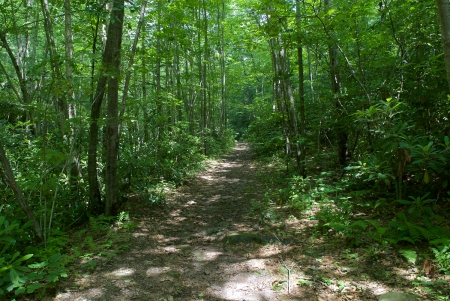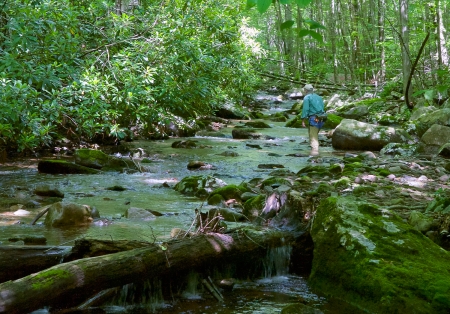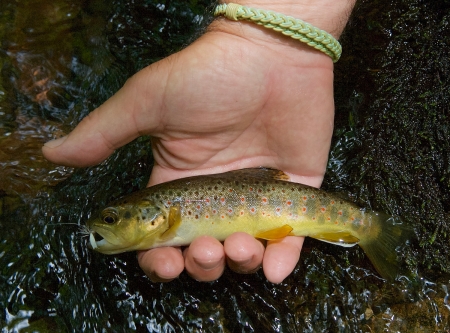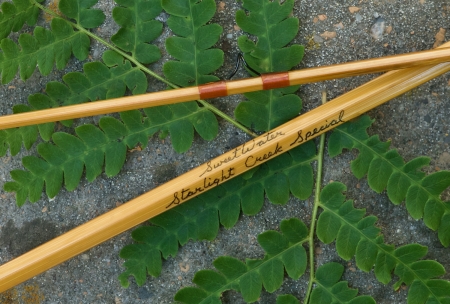
The level of the little stream is lower than I anticipated, down right skinny, with tan, rust, and bluish-colored cobble winking back at me through the current. My expectations had been raised when a rainstorm swept through our region earlier in the week, but the little stream appears subdued since the last time I waded through its cheerful riffles and runs. Approaching high summer, I should’ve known better.
Earlier, while walking down the path to the stream, I could hear the periodic sound of the season’s first cicadas high up in the hardwood canopy. Gone were the bluets and violets that graced the trail along the edge of the brook. These days, summer grass, garlic mustard, and jewel weed compete with various species of ferns.

When I step into the stream, a frog hops into the water with a loud plop. Above me, sun-dappled spider webs glitter with dew. Rhododendron blossoms are nearing their end. Now and then one of the delicate petals floats past my wading boot.
Runs that had been as high as my calves are now lifeless sloughs. Riffles are ankle deep. Thankfully for the fish, springs keep the water quite cold, and although at first glance, the little stream appears low, upon closer inspection, the current remains frisky in a few places. Now and again, I spy a piece of water no more than a few inches wide and at best a foot deep. A high-riding dry fly dappled over one of these variations in otherwise shallow water brings a splash. More often than not, a brown trout flashes under the surface before I manage to set the hook.
Farther along, there remain numerous plunge pools as the gradient steepens. The consistent force of the current falling between boulders carves into the cobble below. The cavity formed by the rush of water provides room for a fish to enjoy oxygenated water while feeding on whatever the current may sweep its way. The miniature fall of water also provides a safe haven under which a brown trout can dash at the hint of danger.
Fishing this small stream, a river angler might think it easy to take a trout in such tight quarters, but nothing is farther from the truth. Each pool might be only twelve inches wide and perhaps twice as long, but dissecting it is no easier than comprehending a run measured in yards rather than inches.
At the head of the pool, a plunge of white water falls down between a series of boulders, creating a brief run for a foot or so before the current widens into the next set of shallow riffles. A palm-sized brown trout may be lying under the fall of water, on either side of the current, or in the tail of the miniature run, before it dissipates into the riffles below. On larger water, it is often necessary to solve the puzzle of which fly pattern to use. Here, any fly will take fish if drifted with care. The problem is that the first cast will spook these trout if not placed an inch or so above where it’s holding.
This morning, my first few attempts have resulted in fish fleeing toward the head of each pool. Crouching low, I now false cast toward the far bank, changing the course of my forward cast to place the #12 pheasant tail, with its parachute wing, at the top of the diminutive run. The fly is undisturbed as it floats down the edge of the current into the bottom of the pool. Subsequent casts aimed at the other edge of the current, and then into the foam below the fall of the water, prove equally ineffective.
A few steps farther upstream, I try again. This time there’s a splash, but I only prick the fish that streaks for cover. Through frustrating trial and effort, I determine that the fish are holding at the back of the current rather than along its sides. Another plunge pool, this time, the pheasant tail alights at the center of the run, traveling innocently for a few inches until it’s lost in a swirl.

By the end of the morning, my shirt is soaked with perspiration. My neck and ears sting from the relentless attack of mosquitoes and gnats. Sitting on a boulder, I unknot my neckerchief and dunk it in the cool water. I run the dripping wet fabric over my head, face, and the back of my hands, wiping away the bug dope while providing momentary relief from the heat and rising humidity.

Breaking down the seven-foot, three-inch Starlight Creek Special, I take a few moments to reflect on today’s outing. I’ve nicked a number of fish and spooked even more. With air temperatures rising into the nineties, it may be some time before I return to this little stream. Until then, I’ll have the memory of six wild brown trout, each with brilliant orange spots along their flanks and plump bellies the color of butter dripping off summer corn.
July 20, 2019 at 5:22 pm |
Very nice read Bob Cheers Rich
Sent from Yahoo Mail for iPhone
July 20, 2019 at 10:59 pm |
Thanks, Rich. Gotta love those little streams!
July 21, 2019 at 11:21 am |
Nice for late July. I always enjoyed the orange spots on the brown trout in the little brook. Some storms are expected tomorrow which should help the flow and keep us out of drought conditions. I do miss being close to the little brook but I will make the 130+ mile trip again in the Fall if the flows remain good.
July 21, 2019 at 11:34 am |
Pat, glad you’re enjoying the blog. The little stream and those other headwaters in the region have been fishing exceptional well through last weekend. With temps hitting 100 this weekend, I’m giving the trout a break, and waiting for that very storm to improve conditions. Stay cool!